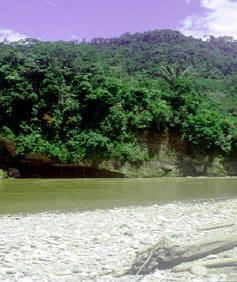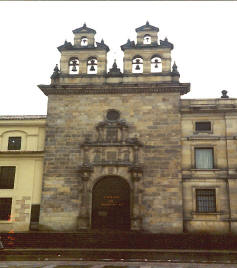|
||||||
|
Attractions
Bogotá Bogotá, the country's capital, is the quintessence of all things Colombian: a city of futuristic architecture, a vibrant and diverse cultural and intellectual life, splendid colonial churches and brilliant museums. It is also a city of Dickensian waifs, beggars, shantytowns, drug dealers and traffic jams. This amazing mixture of prosperity and poverty, Maseratis and mules, makes it one of the world's most chaotic, fascinating and aggressive metropolises.
Sights to look out for include: Museo del Oro, which contains many relics of pre-Colombian history and is perhaps the most important museum of its kind in the world; Museo Nacional, which contains a wealth of exhibits ranging from pre-Columbian to contemporary art; Iglesia de Santa Clara, with its fresco-lined interior, images and altarpieces; Iglesia de San Ignacio, one of the most richly decorated churches in the country; the colonial barrio of La Candelaria, the oldest quarter in the city; Cerro de Monserrate, a peak flanking the city which is famous as a site of many miracles; and Jardin Botánico José Celestino Mutis, a lovely botanical garden featuring a variety of national flora. |
|
||
|
Walking the city's streets and observing the mad to-ing and fro-ing, the avalanches of busetas, the extravagant stores and roadside stalls, is as fascinating as contemplating the serene atmosphere of the city's colonial churches and museums, so give yourself plenty of time for this sort of exploration. It's worth hanging out and watching the buskers at the Plaza de Santander, browsing at the Sunday flea market at Mercado de las Pulgas and looking (but not buying) at the street emerald market at the southwestern corner of Avenida Jiménez and Carrera 7.
There is also a lively arts and entertainment scene that features theater and classical musical, discos amplifying sinuous Cuban rhythms in the trendy Zona Rosa, around Carrera 15, plus plenty of venues for watching soccer and bullfighting. Most budget travelers gravitate to La Candelaria, which has cheap accommodation and food.
Fifty kilometers (31mi) northeast of Bogotá is the colonial town of Guatavita and the famous Laguna de Guatavita, the ritual center and sacred lake of the Musica Indians, and the cradle of the El Dorado myth.
Cartagena & the Caribbean Coast Cartagena de Indias is legendary both for its history and its beauty. It has been immortalized on countless canvases, glorified in hundreds of books and had its every detail photographed a zillion times - and, as Colombia's most fascinating city, it deserves every one of these tributes.
The walled old town of this fortified Spanish colonial port is a gem. It's packed with churches, monasteries, plazas, palaces and noble mansions with overhanging balconies and shady patios. It pays to just wander through the old town, but some of the highlights are the Palacio de la Inquisición; the colonial mansion Casa del Marqués de Valdehoyos; and the lovely old port of Cartagena on the Bahía de las Ánimas.
The less touristy Getsemaní, the outer walled town, also has charming pockets but is not so well-preserved. Nearby, there are a handful of impressive Spanish forts, including the 17th-century Castillo de San Felipe de Barajas, undoubtedly the greatest and strongest fortress ever built by the Spaniards in their colonies. The Islas del Rosario, 30km (20mi) offshore southwest of Cartegena, have magnificent coral reefs and abundant marine life, making them popular with snorkelers and scuba divers. The L-shaped peninsula south of the old town contains the upmarket holiday resorts of Bocagrande and El Laguito. Most budget travelers stay in Getsemaní; there are mid-range options in the old town.
Other highlights of Colombia's Caribbean coast include the town of Mompós, which is an architectural showcase; the beaches of the Parque Nacional Tayrona; the Sierra Nevada de Santa Marta, the tallest coastal mountain range in the world; the mud volcanoes of Arboletes; and, deep in the jungle, the ancient city of the Tayrona Indians, La Ciudad Perdida, which is the largest archaeological find in the Americas this century.
|
|||


